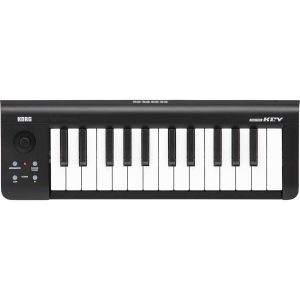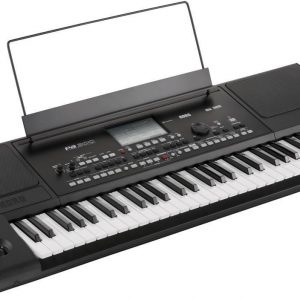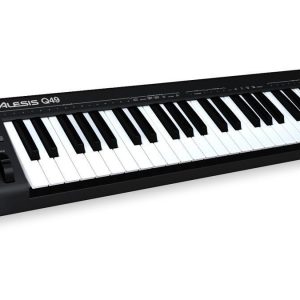Description
M-Audio Code 25 MIDI device is a versatile keyboard controller that is capable of enhancing your music production experience. It is an excellent choice for both beginners and advanced users who are looking for a powerful and user-friendly MIDI device. When you get your hands on the M-Audio Code 25, you will see that it offers everything you need to create music effectively.
Here is what you need to know about the M-Audio Code 25 MIDI device:
Design and Build Quality:
The M-Audio Code 25 has been designed with a sleek and modern design that makes it visually appealing. It features a semi-weighted keybed that feels great to play and makes it an ideal option for those who prefer a more tactile feel when producing music. The keys are velocity-sensitive, meaning they respond to the pressure applied by the player, providing an added level of expressiveness.
The device is compact, making it easy to transport around, which is also useful for those who like to take their music production on the go. The build quality is solid with all components made to withstand the rigors of regular use.
Integration with DAWs:
The M-Audio Code 25 is compatible with most popular DAWs, which means it can integrate seamlessly into your existing music production setup. It works well with software such as Ableton Live, Logic Pro, and FL Studio, meaning you can easily control your DAW’s functions with the M-Audio Code 25’s controls.
Controls and Features:
The M-Audio Code 25 MIDI device comes loaded with an impressive range of controls that are both customizable and versatile. The device features several knobs, faders, and buttons that can be mapped to your software of choice, allowing you to control various functions such as volume, panning, and effects. The device also features backlit drum pads that can be used for programming beats and triggering samples.
Additional features included are an LCD display, sustain pedal input, pitch and modulation wheels, and octave controls for expanding your range. All of these functions make it easier to create complex productions, and they do so in a intuitive way that makes the device user-friendly.
Connectivity:
The M-Audio Code 25 can be connected to your computer via USB, which enables you to easily transmit MIDI data between your device and DAW. The device also has additional MIDI outputs for connecting to external equipment, such as hardware synthesizers, establishing a versatile recording and performance setup.
Conclusion:
The M-Audio Code 25 MIDI device is a great option for those looking for an affordable and versatile MIDI keyboard. Its semi-weighted keybed, customizable controls, and compact design make it an excellent choice for both beginners and professionals. The device is easy to use, and its integration with most popular DAWs makes it a seamless addition to any music production setup.
M-Audio Code 25 properties
| Product name | Code 25 |
| Brand | M-Audio |
| Type | Keyboard Instruments |
| Keyboard Instrument | MIDI Keyboard |
| Drawbars/Sliders | Yes |
| Pads | Yes |
| Rotary Controls | Yes |
| Colour | White |







Micah –
After purchasing the M-Audio Code 25 from this online shop, my overall experience has been quite positive. I would rate it a 4 out of 5. The delivery was prompt, and the packaging was secure, ensuring that the product arrived in perfect condition.
As for the M-Audio Code 25 itself, I have found it to be a reliable and versatile MIDI keyboard. It has all the essential features that I was looking for during my vacation. The keys are responsive, providing a great playing experience. The build quality is sturdy, and the overall design is sleek and professional.
In terms of comparing amateur and professional use of the M-Audio Code 25, I would say that it caters to both groups effectively. For amateur musicians or beginners, the keyboard offers a user-friendly interface and easy integration with music production software. The intuitive controls and clear labeling make it accessible for those who are just starting to explore the world of MIDI keyboards.
On the other hand, professionals will appreciate the advanced features and functionality that the M-Audio Code 25 has to offer. The semi-weighted keys give a more realistic feel, allowing for expressive playing. The abundance of assignable knobs, faders, and buttons provide extensive control options, making it suitable for complex setups and professional-grade productions.
One standout feature of the M-Audio Code 25 is its pads. They are highly responsive and offer a great playing experience. Whether you’re triggering samples, creating drum patterns, or controlling various functions within software, the pads are a valuable addition to the keyboard. With the ability to adjust sensitivity and assign different functions, they enhance the overall versatility of the instrument.
In conclusion, the M-Audio Code 25 is a reliable and versatile MIDI keyboard that caters to both amateurs and professionals. Its sturdy build, responsive keys, and extensive control options make it a valuable tool for music production. With its impressive pads, it offers an added layer of versatility for various applications. I am satisfied with my purchase and would recommend it to others in need of a quality MIDI keyboard.
Cameron –
I recently dined at Jamie’s Italian in Perth with my friend Mariana Chen, where we indulged in a delicious pork chop smothered in an apricot pan sauce. However, our conversation quickly turned to the secretary of our office who had been using the same MIDI keyboard for years! It was then that I knew we needed to upgrade her to the M-Audio Code 25.
The economy in Perth seemed to be doing well, with plenty of businesses thriving online despite global markets bracing for major central bank decisions amid high inflation. Even our beloved secretary couldn’t resist the call of a new MIDI keyboard!
What sets the M-Audio Code 25 apart is its Rotary Controls feature, which allows users to manipulate sound parameters effortlessly and precisely. This innovative technology makes it an indispensable tool for musicians and producers alike. While I might be cynical enough to suggest that the secretary’s love for the new MIDI keyboard was driven by her desire to impress the boss with her technical prowess, who am I to judge? In today’s fast-paced world, keeping up with technology is essential.
Overall, the M-Audio Code 25 is a fantastic addition to any musician’s arsenal. Its unique features and user-friendly design make it an excellent choice for those looking to take their musical production to the next level.
Nathaniel –
Joy! Let me just contain my excitement while I write this review that completely contradicts the opinion of Micah, the so-called expert who rated the M-Audio Code 25 a whopping 4 out of 5.
But before I get started, let me take a moment to appreciate the utter brilliance of the researchers who discovered fossils of the extinct Caribbean monkey Antillothrix bernensis in the Dominican Republic. I mean, who needs to review a MIDI keyboard when you can talk about ancient monkeys that were probably eaten by owls? It’s like, priorities people!
Now, let me get back to the task at hand.
Micah says the M-Audio Code 25 is reliable and versatile. Oh please, it’s more like a piece of junk that will break as soon as you look at it funny. I mean, have you ever tried to adjust the sensitivity on those pads? It’s like trying to solve a Rubik’s cube blindfolded while being attacked by a swarm of bees.
And don’t even get me started on the keys. Semi-weighted? More like semi-useless. They’re like playing a game of piano Twister, except instead of getting dizzy and falling over, you just get frustrated and want to scream at the top of your lungs.
But hey, Micah says it’s great for both amateur and professional musicians. Yeah, because nothing says professional like using a MIDI keyboard that’s been collecting dust in the corner of your studio since the Clinton administration.
And those pads? Forget about it. They’re like trying to play a game of musical chairs with a bunch of drunken accountants. Except instead of chairs, it’s just a bunch of random buttons and knobs that do who-knows-what when you press them.
In conclusion, I would rate the M-Audio Code 25 a solid -5 out of 5. It’s a piece of junk that’s only good for one thing: collecting dust in your studio while you wait for the ancient monkey fossil researchers to discover something actually interesting.